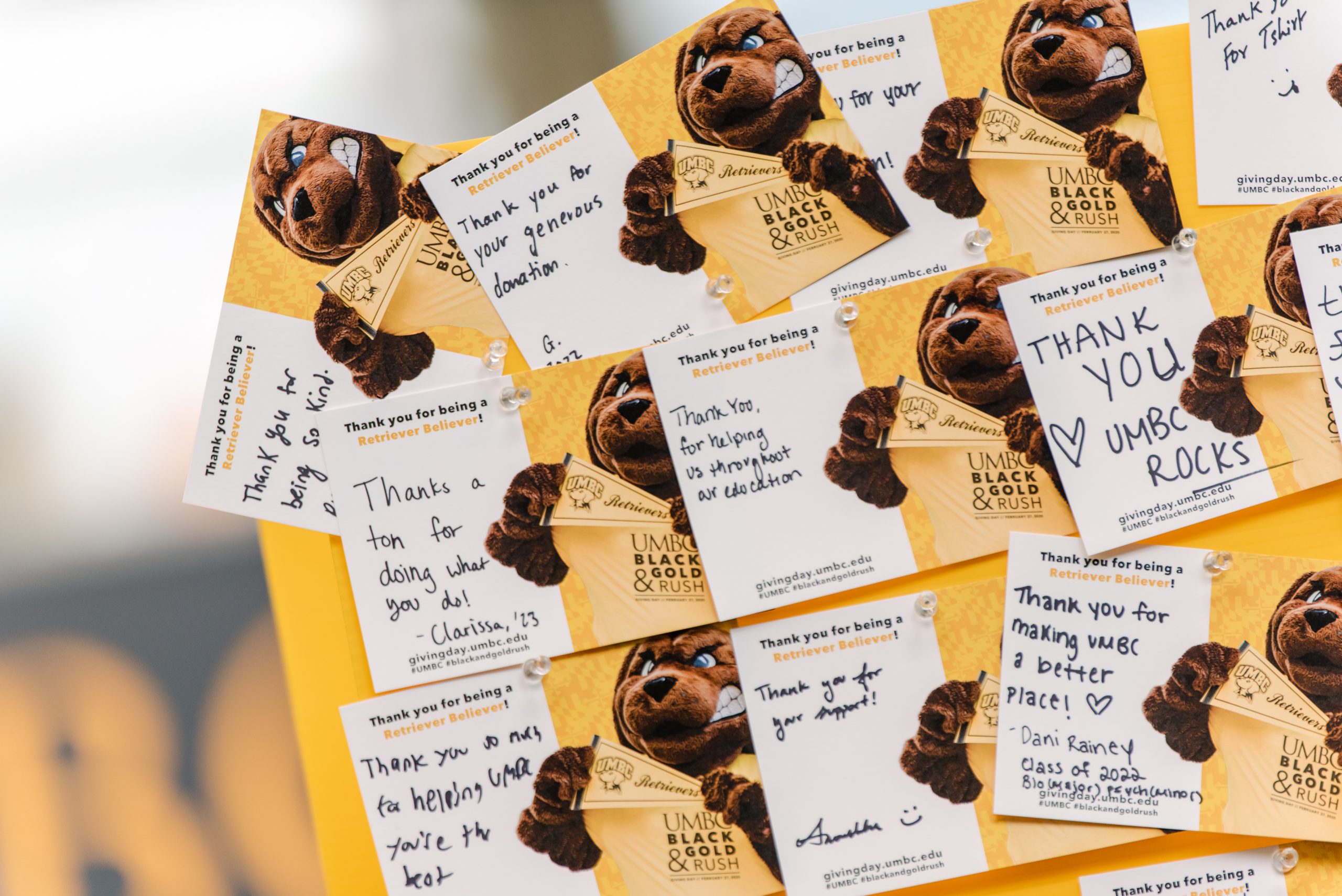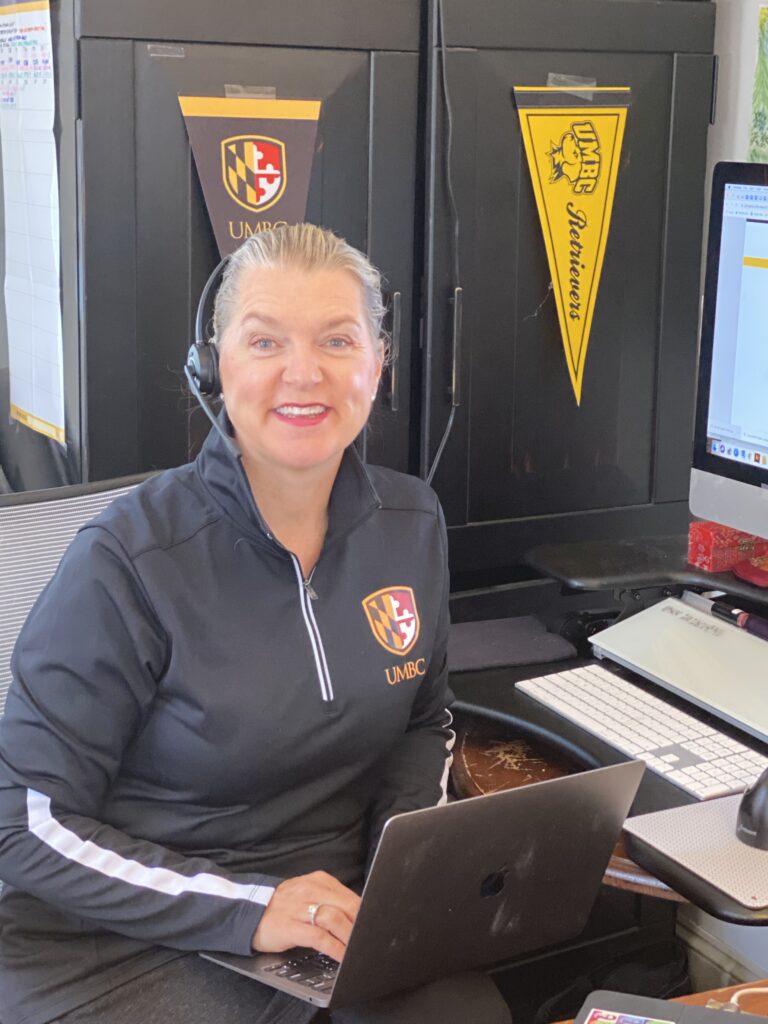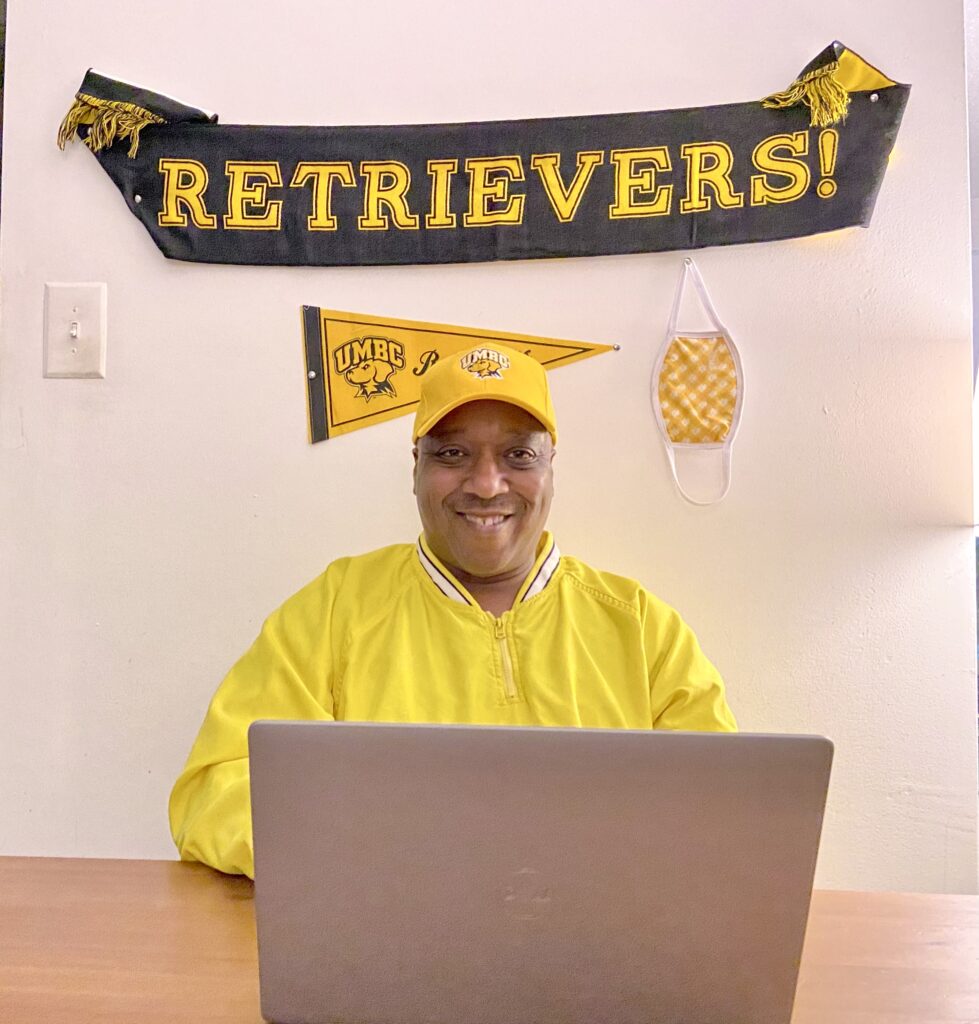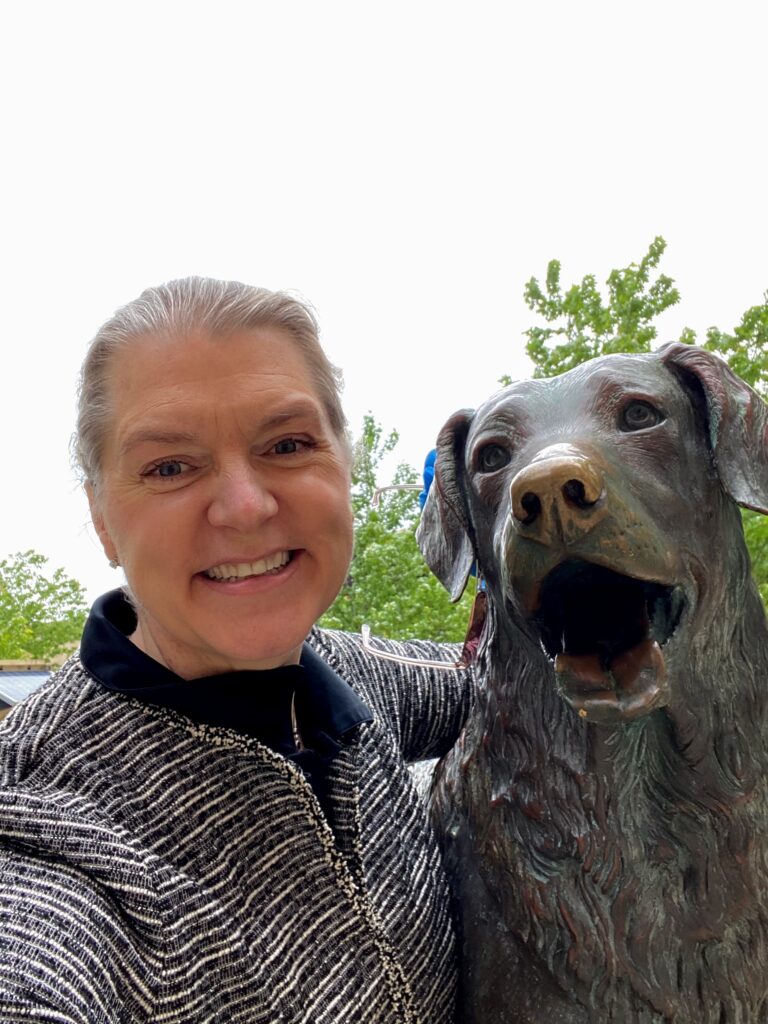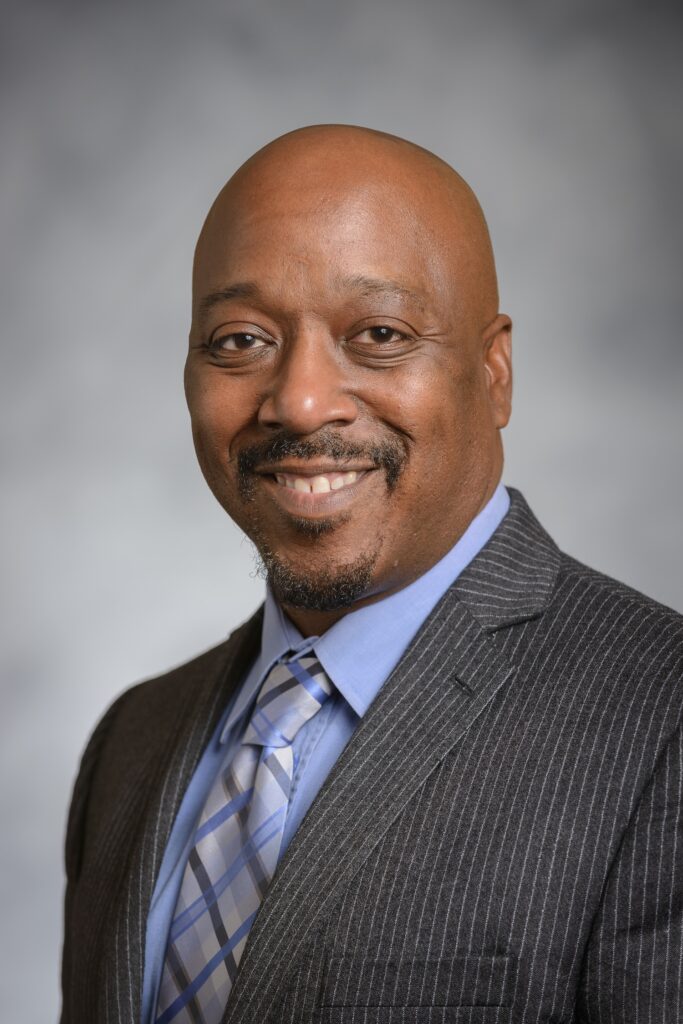Little did we know that 2020’s successful Giving Day would be one of the last major on-campus events before COVID-19 moved UMBC and the rest of the world to a virtual format. Since then, two new staff members have started key roles in UMBC’s Office of Institutional Advancement. Giving Day 2021 will look different from past celebrations, not only because it’s virtual and 36 hours long, but also because its messaging and call to action are spearheaded by faces new to UMBC, but certainly not to the world of giving. Meet Stacey Sickels Locke, associate vice president for Alumni Engagement and Development, and Carl Fowlkes, director of annual giving, two new Retrievers who personally understand the impact and importance a gift can make. And despite working completely remotely since being hired, their Black & Gold pride is front and center.
UMBC Magazine: You both have a storied history with university giving—can you tell me about your first role in giving and why the career path stuck?
Stacey Sickels Locke: My first volunteer experience was as a student at Sweet Briar College. I loved my college and gave admissions tours and then was hired as a student phonathon caller. I found myself enjoying calling alumnae, hearing about their lives, and seeing how they applied their education. Rarely did I actually need to ask people to give; usually they volunteered as they knew why I was calling. At my fifth reunion, my college asked me to come work full time and my career was launched.
Carl Fowlkes: When I went to the University of Connecticut for my graduate degree, they had an opening for an assistant director to manage their student phonathon. I had experience doing survey calls, so it was a translatable skill to fundraising calls. I found that I liked working with the students and alumni, and after six months I was promoted to interim director of annual giving and I continued on that path.
UMBC Magazine: For those outside of the giving world, can you explain some of the day-to-day duties of your positions?
SSL: I think we have the very best jobs on a university campus—we work with generous people who love their institution and who want to give back. My favorite part of my job is working with donors. Right now I am working with someone who has fond memories of their academic department and wants to do something transformational. Each week, I meet with deans, program directors, and other university leaders to explore how alumni and philanthropy can impact their programs.
CF: Most of my day to day involves working with data and spreadsheets. I’m looking at reports to see how a previous giving appeal performed and analyzing its effectiveness with targeted audiences. I also spend a fair amount of time responding to alumni and parent questions about their individual giving and the priorities of the university.
I think we have the very best jobs on a university campus—we work with generous people who love their institution and who want to give back.
—Stacey Sickels Locke
UMBC Magazine: Is there a particular instance or story that sticks out to you that makes you say, “Yes, this is why I do this job!”?
SSL: Yes! Early in my time at UMBC last year, I had the honor of working with the Sinha family who established an endowed professorship in honor of their father, Dr. Bimal Sinha in Statistics. Hearing the stories of the Sinha children growing up on the UMBC campus inspired me. Working with the family, my colleagues, and the Statistics Department, we applied for a matching program with the State of Maryland and were able to secure a match bringing the endowment to $1.8 million.
CF: At a prior institution where I worked, we learned about a student living out of his car with his mom and a sibling. We were able to provide support to the student through the student emergency fund to help provide meals, buy schools books, etc. We also were able to connect the mother with childcare for the younger sibling and a generous alumni donor who provided a work opportunity for the mother. The student ended up graduating and was a featured speaker at a donor thank you event…not a dry eye was in the room.
UMBC Magazine: You are both relatively new Retrievers. How would you describe the alumni and (online) campus community so far?
SSL: UMBC is a very special community. Everyone I have met in my time working for the University System of Maryland LOVES working at UMBC. When I was approached about the new associate vice president position, I applied enthusiastically and was thrilled to join this community in May 2020.
CF: I have been struck by the family atmosphere of the UMBC community—the love the students and employees express for UMBC is truly awe-inspiring. Just recently I had a call with an alumna from the class of 1971 and she shared with me what UMBC was like during her time on campus, from the highlights of attending campus concerts to the growing pains of being a new university, and how much she treasures those memories.
UMBC Magazine: What are you looking forward to most when campus reopens?
SSL: Not feeling like I am watching the Netflix version of my job…and I hear I have an office! But seriously, what I most look forward to are the informal moments of connecting in the hallway, at the gym, at a game, or after a meeting.
CF: I miss the personal interactions with students and colleagues and particularly look forward to meeting colleagues who work in different areas on campus that I don’t get to speak with on a regular basis.
UMBC Magazine: Can you talk about the challenges of an online Giving Day and how your team has come up with solutions?
SSL: Days of giving provide an opportunity to rally alumni and friends in a concentrated period of time. The best day for giving is the day when a donor is inspired to give to the project that most inspires them. After giving days, we will work all year long with generous donors making a difference at UMBC.
CF: The main challenge of Giving Day this year is how to engage the Retriever Nation when we can’t capture the on-campus excitement or have impromptu, live interactions with students and faculty to show the impact of giving. Fortunately, our team has worked with students and alumni who sent in personal videos that we will showcase. We have a wonderful student and alumni community who have stepped up to help us in this unusual time.
UMBC Magazine: What do you want Retrievers and others who give to know about where their money is going and what it will be used for?
SSL: My colleagues across campus are extremely diligent in making sure that donor funds are spent as each donor intends. The funds showcased on our Black and Gold Rush are priorities for campus and there are very dedicated people who are eager for these funds to reach students, faculty, and programs.
UMBC Magazine: What is one place outside of UMBC that you give to and why?
SSL: I give to my alma mater, Sweet Briar College, which almost closed in 2015. I joined a group of alumni raising $30M in six months to save the college. This experience (of almost losing my college) made me realize how critical every gift is. I also support my son’s college as I know how important giving from parents can be.
CF: I give to my alma maters, and I give to every university/college I have worked for. Specifically, I like to support scholarships for students in need as I received a full ride scholarship for my undergraduate education and was fortunate to not have a lot of student debt after graduation.
Learn more about supporting UMBC on Giving Day by helping the university reach the goal of 1,966 donations to honor the founding year of Retriever Nation.
*****
Header image of thank you cards from UMBC’s 2020 Giving Day by Marlayna Demond ’11.
Tags: Giving Day

